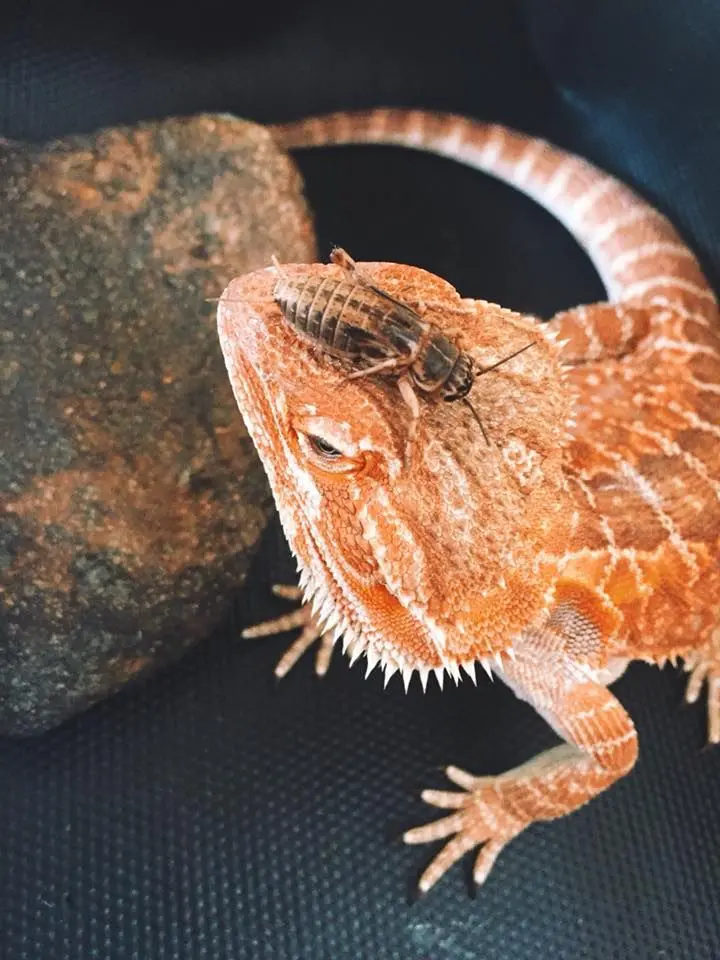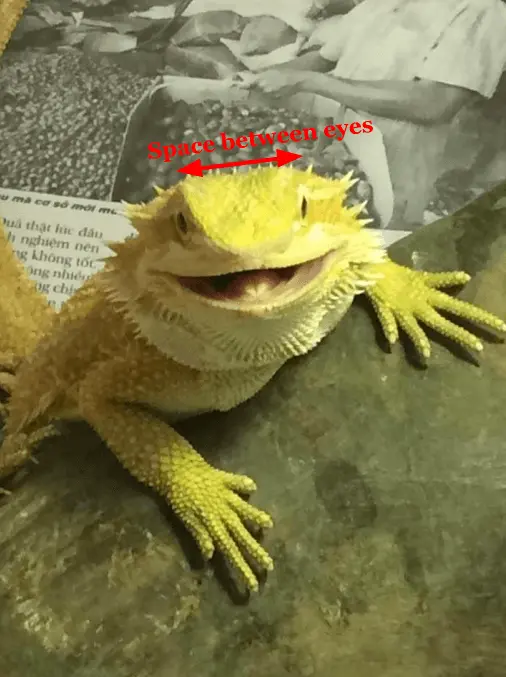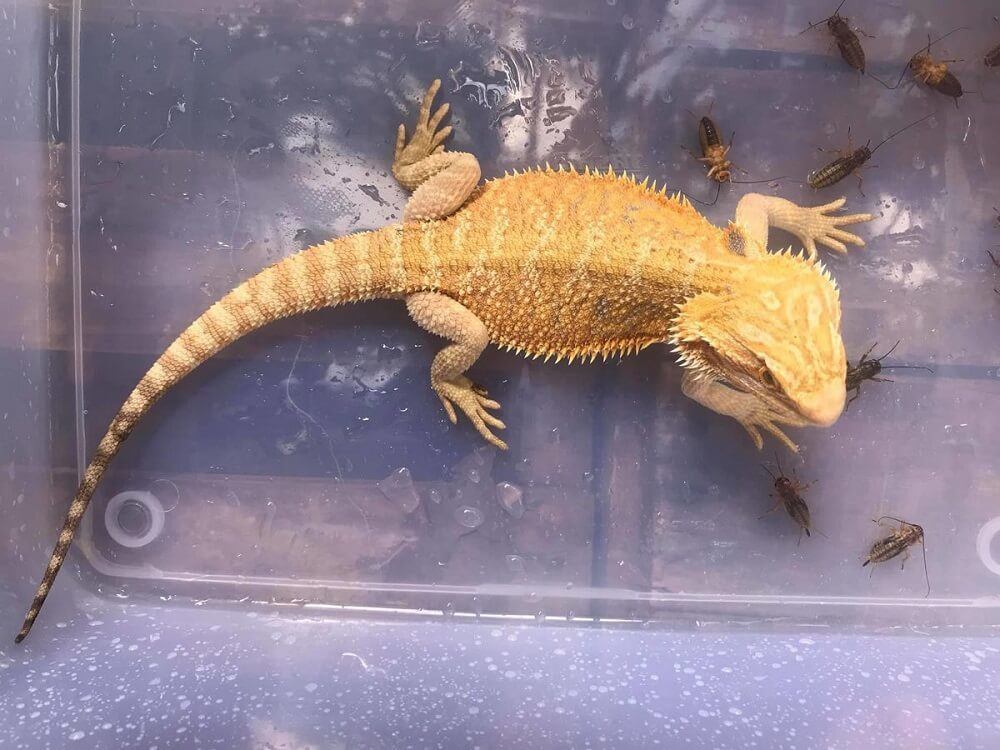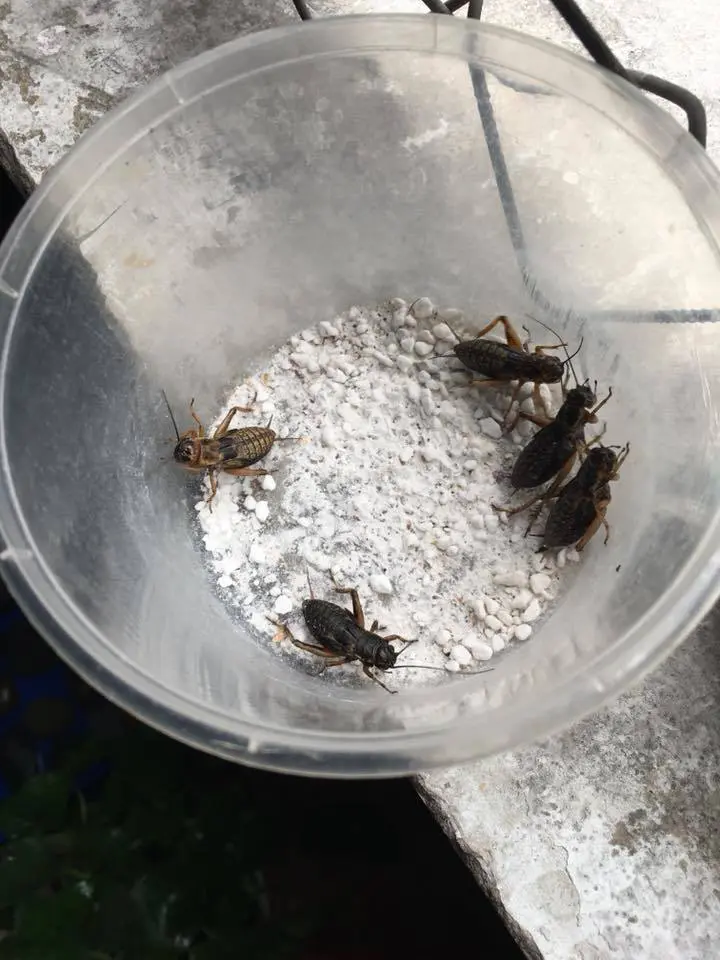Crickets are one of the most common foods fed to reptiles in captivity, including your bearded dragon.
Live crickets encourage natural hunting behavior and provide your pet with the vitamins and minerals that they need, but there are some important things you need to know, such as what size cricket to feed your dragon and how many you should be feeding.
What about gut loading and dusting?
We have listed everything you need to know about feeding crickets to your bearded dragon below.
What Are Feeder Crickets
What are Crickets?

Crickets are insects that are seen around the world and known for their chirping.
They vary in length from 0.1 inches to 2 inches with thin antennae and long hind legs, which help them to jump.
They have stiff fore-wings, along with two long hind wings, which they use to fly.
Types of Crickets
There are numerous types of crickets available to purchase for your bearded dragon, ranging in size from ⅛” to 1”, these include:
- House crickets, which increase vulnerability to CrPV virus.
- Banded crickets, Indian house crickets, these have softer exoskeletons and longer lifespans, along with being immune to the CrPV virus. These are one of the most common choices in bearded dragon owners.
- Black field, Jamaican, African and Mediterranean crickets are commercially available in the United States and Europe, which are also immune to the CrPV virus. Another top choice amongst bearded dragon owners.
Cricket Nutrition
Crickets offer great nutrition, according to weight. They also contain essential amino acids, B12, Omega-3, Omega-6, and more. They contain fat, calcium, zinc, copper, biotin, iron, potassium, and magnesium.
Analysis of Flukerfarms Crickets (before gut loading):
- Moisture 77.58%
- Protein 15.88%
- Fat 3.46%
- Fiber 2.4%
- Calcium .2%
- Phosphorus .95%
Are Crickets Good For Bearded Dragons?
There are pros and cons to any food you will feed your bearded dragon. Crickets are live feeder insects, which means you have to keep them alive until feeding day.

Crickets are the most popular option for bearded dragons.
Pros of Crickets
- Easily available
- Encourage natural hunting behavior
- High in nutrition
- Bearded dragons enjoy themselves
- Protein-rich food source
- Suitable for bearded dragon owners who don’t like cockroaches and worms
Cons of Crickets
- They can be very noisy
- Difficult to catch when they escape with risk of breeding, adding to the noise in your home
- Release a toxin when dying
- Smell terrible
- They bite your dragon and you
- Hard exoskeleton, making them difficult to digest, which can lead to impactions
Where Can I Get Crickets?
The good news is that feeder crickets are easily available. You can purchase them online or at a reputable pet shop.
What Size Should I Buy?
Size is very important when purchasing crickets, ensuring that they are not too big for your dragon to digest. Baby and juvenile bearded dragons should be fed small and young crickets.
Adult bearded dragons enjoy medium sized crickets, which are around 1/2“ to 5/8“ long. These crickets are around three weeks and have soft exoskeletons, to ensure better digestion.
You will feed your dragon different-sized crickets as they get older.
A rule to follow is that the cricket should never be bigger than the difference in space between your bearded dragon’s eyes.

Space between bearded dragon’s eyes
Most shops sell feeder crickets in four sizes, which are pinhead, small, medium, and large.
Pinheads are fed to baby bearded dragons.
The small crickets are slightly bigger than the pinhead, but remain a few millimeters in length, while medium crickets are around one centimeter.
Large crickets are anywhere from two to three centimeters.
How To Store Crickets

When you purchase crickets to feed to your bearded dragon, you will get more than you need, which means you have to keep them alive.
Most bearded dragon owners use a large plastic box to keep their feeder crickets in.
The lid must be secure and the container must be deep enough to ensure the crickets cannot jump out as soon as you remove the lid.
Do not overcrowd the container, as this will increase humidity. Make sure you provide plenty of tiny holes in the lid to allow airflow. Cover the entire lid with holes that are not big enough for the crickets to escape.
Egg cartons are a must, they provide hiding places for your crickets, providing what they need to survive.
You will need to feed your crickets a nutrient-based diet, to provide your bearded dragon with the vitamins and minerals it needs. Food such as grains, wheat breads, and fresh vegetables are ideal.
Feed these to your crickets at least 24 hours before feeding your dragon, this enables the cricket to absorb all those healthy minerals and vitamins before your pet eats them.
See our complete guide to keep crickets alive after purchasing here.
How To Feed Crickets To A Bearded Dragon
Knowing how to feed crickets to your bearded dragon will ensure your pet gets the nutritional values it needs while making your life easier.
Feeding Size
Baby bearded dragons can eat up to eighty crickets a day, while juveniles can eat up to sixty crickets and adults up to around twenty.
The number of crickets fed should be based on your pet’s age and activity levels.
Baby and juvenile bearded dragons need more crickets to assist with their growth, while adults will prefer greens and vegetables with fewer crickets as they age.
It’s very uncommon for bearded dragons to overfeed, they will usually stop eating when they are full. They may store some crickets in their throat for later.
Feeding Schedule
|
Age |
Feeding Frequency |
Crickets Per Feeding |
Crickets Per Day |
|---|---|---|---|
|
Baby | Up to 5 times |
as many as they can within 5 – 10 mins |
25 – 80 |
|
Juvenile |
2 – 3 times |
as many as they can within 5 – 10 mins |
25 – 60 |
|
Transition stage |
2 times |
as many as they can within 5 – 10 mins |
20 – 30 |
|
Adult |
1 time |
as many as they can within 10 – 15 mins |
10 |
Baby Bearded Dragons
Baby bearded dragons under three months should be fed up to five times a day, eating as many crickets as they can in ten minutes.
Juvenile Bearded Dragons
Juveniles from three to twelve months should be fed up to three times a day, eating as much as they can in five to ten minutes.
Adult Bearded Dragons
As your breaded dragon ages, it will transition to greens, reducing its need for crickets per feeding session.
Adult bearded dragons should eat as many crickets as they want in fifteen minutes. You can provide this daily or space it out during meal times.
Where To Feed
There are two options when it comes to feeding, the first is to feed in your pet’s enclosure and the second is to get a separate feeding tank.
If you choose to feed in your pet’s enclosure, it’s recommended to only feed one to two crickets at a time, so you can keep your eye on them and ensure your pet eats them. This eliminates the risk of leaving any crickets in the enclosure overnight.

Feeding crickets in a separated container
A separate container is the easiest and safest feeding method, eliminating any risk of the crickets being left in the enclosure.
Place your pet in the container with the feeder crickets.
After ten to fifteen minutes, return your pet to its enclosure and catch the remaining crickets, returning them to their own tub until the next feeding.
How to Dust with Calcium?

Dusting crickets with Calcium supplement.
It’s essential that you provide your pet with a calcium supplement to reduce the risk of metabolic bone disease.
Place a pinch of calcium supplement in the bottom of a cup. Place one cricket in the cup and gently shake, coating the cricket. Feed your pet immediately.
Most crickets will start cleaning themselves as soon as they are coated with the calcium, so quickly introduce the crickets to your pet.
You can place them in a feeding dish, use tongs or place them one at a time to encourage natural hunting behavior.
Feeding Tips
Feeding crickets can be time-consuming, as the best way to feed your bearded dragon is to feed one cricket at a time. This method is very useful when feeding baby bearded dragons.
You can also try placing a few crickets into your pet’s feeding dish with their veggies.
You can place the crickets in the fridge for a while before feedings, which slows them down. This can make it easier for your dragon to catch them and easier for you to capture any uneaten crickets, removing them from the enclosure.
When feeding live crickets to your bearded dragon, there are some potential problems you may encounter.
- Insects manage to escape – try using a feeding dish or tweezers until your dragon is able to hunt more efficiently
- Crickets hide in decorations in the enclosure – Keep a close eye on the crickets when feeding. Ensure to remove all uneaten crickets
- Crickets climb onto and bite your dragon – consider using a tweezer method or use a separate feeding container to reduce the risk and keep your dragon safe.
Don’t Leave Crickets In The Tank Overnight
Many bearded dragon owners leave crickets in their pet’s enclosures when they cannot find them, which is why you may want to consider feeding one at a time or using a separate feeding container.
Bites
Yes, crickets can and will bite, both you and your bearded dragon.
When they start to get hungry, they will look for food, which includes biting your dragon.
It’s not uncommon for crickets to bite toes, eyelids, and tails of bearded dragons.
Bites are uncomfortable and can become infected if ignored. An escaped cricket will continue biting and stressing your bearded dragon until it has been removed.
Infection
You cannot afford to blink when it comes to feeding crickets inside your bearded dragon’s enclosure, they can hide within seconds.
When left in the enclosure, they will continue to explore, stepping in waste and left-over food.
If your humidity levels are slightly too high, the problem can become very serious.
The slightest nip or scratch on your dragon and the risk of infection is dramatically increased with the number of bacteria the crickets have moved through the enclosure.
Stress
When you leave crickets in your bearded dragon’s enclosure, they harass your dragon, causing unwelcome stress.
It can even put your dragon off eating crickets in the future.
Crickets can make your pet feel uncomfortable in its enclosure as stress leads to other more serious health concerns.
In case you left crickets in your bearded dragon habitat by mistake or they escaped from the storage, we have some tips to remove crickets.
Can I Feed Dried Crickets?
Freeze-dried crickets are great bearded dragon treats, but they are not suitable as a regular and nutritious food source.
When crickets are dried, they lose their nutritional content, along with their moisture, both of which benefit your dragon.
If you feed dried crickets too much, you also increase the risk of impaction.
Summary
Crickets are a great nutritional source for bearded dragons, but you need to ensure you know what size and how many crickets to feed your pet on a regular basis.
Ensure all crickets are gut loaded and coated in calcium supplement, ensuring your pet gets the best nutritional values to help them stay strong, healthy and happy.